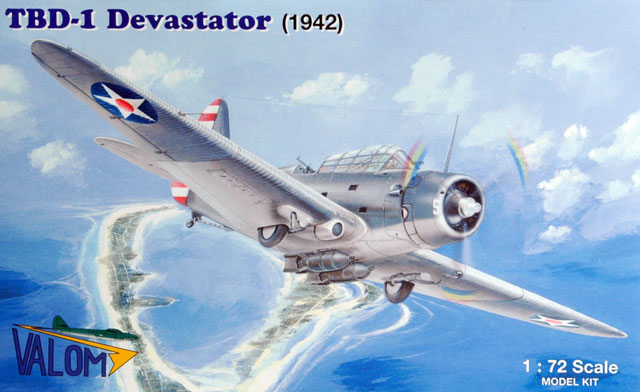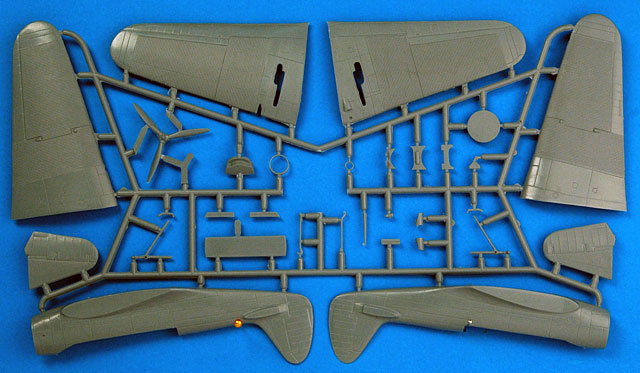|
TBD-1 Devastator
early 1938 and
1942 versions

Valom 1/72
S
u m m a r y
|
| Catalogue Number: |
Valom kit No. 72011 (early 1938) and
72012 (1942) |
| Scale: |
1/72 |
| Contents and Media: |
31 mid grey plastic parts on one
sprue, 2 clear parts in injection moulded plastic, 19 well moulded resin
parts, 26 PE parts on one fret, decals for two aircraft plus a 6 page A5
instruction booklet with history, parts plan, 12 build diagrams and two
pages of paint/decal drawings. |
| Price: |
|
| Review Type: |
FirstLook |
| Advantages: |
Important US navy subject, very good
resin detail, excellent decals by Aviprint. |
| Disadvantages: |
Panel detail a little heavy,
injection moulded prop a bit vague in its shape; injection moulded,
one-piece canopy is thick and may be better replaced with a vac-formed
item. |
| Recommendation: |
Recommended |
Reviewed by Glen Porter

Valom's 1/72 scale
TBD-1 Devastator kits will be available online from Squadron.com
I find it hard to understand why the TBD Devastator has been
overlooked by the major manufacturers in this scale for so long, as it
was the first all-metal monoplane for the US Navy.
The design by Douglas, first flown in 1935, had many innovations
compared to its biplane competition. The first aircraft were issued to
VT-3 aboard USS Saratoga and others participated in the attacks on the
Marshall and Gilbert Islands, the Coral Sea Battle but were given a
hiding at Midway then with-drawn from front-line service shortly
afterwards in August 1942.
Valom has released two kits simultaneously and the only difference is
the colour scheme, decals and offensive armaments. Kit No. 72011 is the
pre-war example, in a suitably colourful scheme, with a torpedo and
associated equipment. No. 72012 is in Blue/grey and Light/grey with two
500 lb bombs at Wake and on the Big E in 1942.
The single mid-grey plastic sprue is pretty good for a short-run kit
with minimum flash and only a few minor sink marks. The prop is probably
the worst of the parts with its shape being a little vague and some sink
marks evident on the blades but still usable with some clean-up. In my
opinion, panel detail is somewhat heavy, not as bad as Matchbox's
trenches but not quite as subtle as the newest Japanese kits.

Click the thumbnails below to view larger images:
The one-piece canopy is a bit thick so if you want to show off all
that lovely interior detail by opening it up, it may be easier to
replace it with a vac-formed example.
The highlight of Valomís kits is often the resin, and this release is no
exception. There is a one-piece cockpit floor with the two front sears,
side consoles and other items that would be fixed to the floor plus
separate gunner's seat, fun stick, roll-over bar, gun sight and rear
machine gun. There is also a beautifully detailed radial engine and
suitably thin-walled cowling to go over it. 2 two-piece 500lb bombs for
the 1942 version and a resin torpedo and cavity in the early one.

The only disappointment in the resin is the wheels. These are
beautifully moulded but with an air bubble in the outside wall of each
tyre. This shouldn't be hard to fill but you will lose some of the
detail in the process.
The PE includes instrument panel, rudder pedals, seat belts, DF loop and
torpedo props and fins among others.
There are markings for two aircraft in each kit. The early (1938)
covers one each for Saratoga and Lexington in the appropriate pre-war
colours and the other (1942) for Wake Island and USS Enterprise in
early-war Blue/Grey and Light grey.
Valomís Devastators are not perfect but apart from the aforementioned
comments should, with some extra work, build into very nice and highly
detailed models.
Recommended.
Thanks to Valom for this review
sample.
Review and Images Copyright © 2005 by Glen Porter
Page Created 30 January, 2006
Last updated 29 January, 2006
Back to HyperScale Main Page
Back to Reviews Page
|
Home | What's
New | Features
| Gallery |
Reviews | Reference
| Forum
| Search